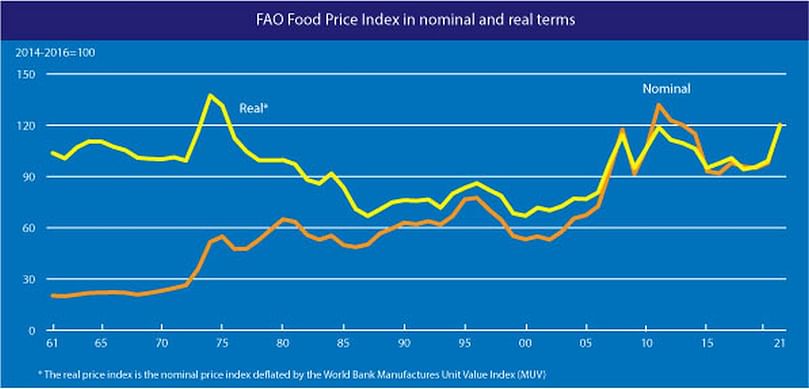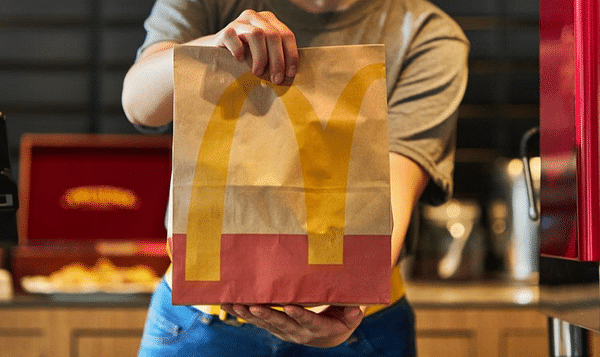After twelve months of consecutive rise, the FAO Food Price Index fell in June.
After twelve months of consecutive rise, the FAO Food Price Index fell in June

The FAO Food Price Index (FFPI) averaged 124.6 points in June 2021, down 3.2 points (2.5 percent) from May, but still 31.5 points (33.9 percent) higher than its level in the same period last year.
The decline in June marked the first drop in the FFPI following twelve consecutive monthly increases.
The drop in June reflected declines in the prices of vegetable oils, cereals, and, to a lesser degree, dairy prices, which more than offset generally higher meat and sugar quotations.
The FAO Cereal Price Index averaged 129.4 points in June, down 3.5 points (2.6 percent) from May but still 32.7 points (33.8 percent) above its June 2020 value.
After reaching their highest level in May since January 2013, international maize prices dropped by 5.0 percent in June, yet remained over 72 percent higher than in the same period last year.
Maize prices in Argentina fell with increased supplies from recent harvests as a result of higher-than-earlier expected yields. Despite drought damage, ongoing harvests also put downward pressure on maize prices in Brazil.
In the United States of America, maize prices fell towards the end of the month as rainfall improved crop conditions in some areas. Among other coarse grains, international barley and sorghum prices also softened in June, falling by 2.2 percent and 4.9 percent, respectively.
International wheat prices declined slightly (by 0.8 percent) in June, but remained above last year's values by over 31 percent.
A favorable global outlook supported by improved production prospects in many key producers outweighed upward pressure from dry conditions affecting crops in North America.
International rice prices also fell in June, hitting fifteen-month lows, as high freight costs and container shortages continued to limit export sales.
The FAO Vegetable Oil Price Index averaged 157.5 points in June, falling by 17.2 points (or 9.8 percent) from May and marking a four-month low. The sizeable month-on-month drop mainly reflects lower prices of palm, soy, and sunflower oils.
After rising for twelve consecutive months, international palm oil quotations retreated in June, chiefly influenced by prospective seasonal production gains in leading producing countries and a lack of fresh import demand.
Meanwhile, subdued global import demand also exerted downward pressure on soy and sunflower oil prices.
In the case of soyoil, expectations of lower-than-earlier anticipated uptake from biodiesel producers in the United States of America further weighed on prices.
By contrast, international rapeseed oil quotations withstood the downward overall trend in vegetable oil prices, underpinned by prospects of recovering demand in the European Union on easing lockdown measures.
The FAO Dairy Price Index averaged 119.9 points in June, down 1.2 points (1.0 percent) from May, ending twelve months of uninterrupted increases.
At this level, the index value stood 21.6 points (22.0 percent) above its value in the corresponding month last year.
In June, international quotations for all dairy products represented in the index fell, with butter registering the highest drop, underpinned by a fast decline in global import demand and a slight increase in inventories, especially in Europe.
Whole milk powder prices declined on reduced purchases by China and lower demand for spot supplies, while global export availabilities remained adequate to meet existing orders.
International quotations for cheese and skim milk powder declined slightly also to reduced global import demand amid somewhat higher export supplies from major producing regions.
The FAO Meat Price Index* averaged 109.6 points in June, up 2.2 points (2.1 percent) from its revised value for May, continuing the increases for the ninth consecutive month and placing the index 15.6 percent above the corresponding month last year, but still, 8.0 percent below its peak reached in August 2014.
In June, price quotations for all meat types represented in the index rose, primarily underpinned by firm global import demand, as increases in imports by some East Asian countries compensated for a slowdown in China’s meat purchases, especially of pig meat.
Tightening export supplies also provided price support across all meat products, reflecting multiple factors, including low poultry meat inventories in the United States of America, limited supply of slaughter-ready animals in Brazil and Oceania, and some recovery in food services sales in major exporting countries.
The FAO Sugar Price Index averaged 107.7 points in June, up slightly by 0.9 points (0.9 percent) from May, marking the third consecutive monthly increase and reaching a new multi-year high.
Uncertainties over the impact of unfavorable weather conditions on crop yields in Brazil, the world's largest sugar exporter, exerted upward pressure on prices. The recent increase in crude oil prices and an appreciation of the Brazilian Real against the US dollar in June lent additional support to world sugar quotations.
Higher energy prices tend to prompt producers in Brazil to divert more sugarcane crushing to ethanol production, while the stronger currency tends to negatively affect exports.
On the other hand, good production and export prospects in India had partly offset the overall upward pressure on international sugar prices and prevented larger monthly increases.











